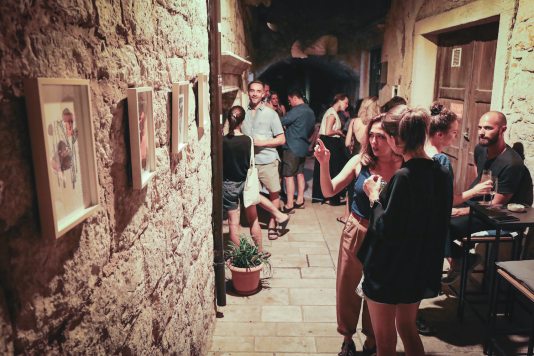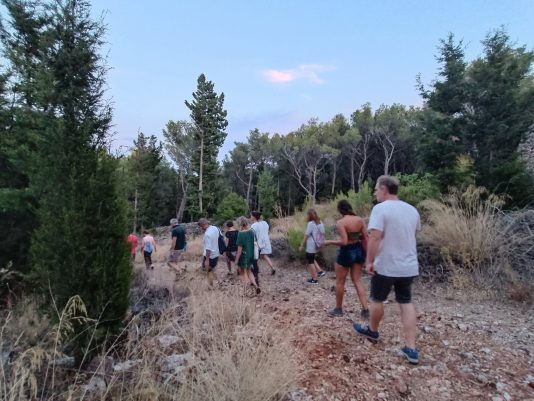LUCIJA BUŽANČIĆ
Context
The global context of this year’s programme is shaped by the need to react to the war in Ukraine and the ongoing concern about the global environmental crisis. Locally, our focus was on the creation of the new space of artistic production in which Lab852 was involved – Monade Gallery in Jelsa, Island Hvar, as a home of the main cultural event that we produce – Jelsa Art Biennial.
The space is in the historical centre of the town and as such it is a protected cultural asset. In terms of use, the space historically functioned as a food storage, and later as wine making and storage space. Due to its primary function (cooling, drying), the space is buried practically below the sea level and located in the “Kala” – a street in the grid of a Mediterranean city and according to more consistent urban plans, placed favourably in relation to the direction of the winds. Entrance from the street added a public and social function to it in the season of grape harvest and wine production when interactions were spontaneously happening in an open-door manner.
More recently, because of the fragmentation of the family property and changes in its functions brought by the mass tourism, the space functioned as a storage space for the surrounding businesses. Air conditioners, ventilation and garbage depot began to dominate the view of the kala and with the seasonal suspension of traffic on the waterfront (the parallel main street), all motor traffic of the place spontaneously moved to the kala, despite the bans. It negatively affected the safety of pedestrian traffic and the quality of life of residents. These circumstances resulted in conflicts between different users, which was important to take into account when designing a new use for the space and planning the program.
Taking into consideration the needs of different users of the inner private space (local environmental association, contemporary art production company and commercial business) as well as the outer public space (pedestrians, residents), architect Zdravko Krasić designed a space that has the possibility of functioning as a gallery, bar, shop, space for workshops and lectures. With the design of urban furniture that enables the simultaneous retention and passage of pedestrians, a balance was created between the private and the public use of this extremely limited space, which at the same time completely cancelled motor traffic through the street.
Architect Josipa Slaviček approached the space theoretically and, as part of this year’s activities and did preliminary research on the context of program development. Sustainability and circularity reflected in the ability of the space to programmatically adapt to seasonal changes and different types of users was also a conceptual basis of the exhibition program, used by artists in residence for their work on site specific projects. From this point of departure and taking into account the context of the space, its historical tasks, current state and vitality, the exhibition program leaves the very framework of the gallery and spreads along the street to the benefit of all residents and passers-by.
Program Postcards
Within previously mentioned context, program Postcards was developed to encourage research and evaluation of the lesser-known elements of the local heritage of Jelsa and the island of Hvar and their (re)interpretation outside of the usual tourist-commercial narrative. Using the very idea of a postcard as a format for presenting a place to “others”, the aim was to strengthen the sense of the local identity based on the richness of one’s own cultural and natural heritage, traditions, relationships, and community practices that contribute to their preservation and development. The program started with an Open Call for artists in June and consisted of four exhibitions that were results of four residencies during July, August and September. Including local community in every designed activity, and running parallel to the main part, the program was accompanied with two thematic walks with expert collaborator, an interactive shadow hunt on the island and Kids2kids workshop. The entire program took place in the year prior to Jelsa Art Biennial. As such, it was part of the process to develop a concept for Jelsa Art Biennial 2023.
Postcards 02_The Shade
Our second residency heavily relied on the activities held by our expert collaborator Kristina Lazaneo. She held educational walks through Jelsa and in the first thematic walk with our glances directed “up” above our heads, Kristina led the engaged member of Jelsa community in search of shade over the canopies of public spaces, observing the plants that live and grow right in that horizon. The walk provided numerous interesting facts about plants and their benefits, as well as presented existing issues and the influence of surrounding factors on local vegetation. With a help of our collaborator, artists in residency and Slovenian organization Prostoroz, we launched an interactive shadow hunt and tried to mark as many cold and hot micro-locations as possible on the island of Hvar, so that the data obtained could be used for proposals on measures and initiatives of public space in the service of a better and more pleasant life for the islanders. These difficulties and the bias about the local plants intrigued the second artist in residency – illustrator and animator – Lucija Bužančić. At the time when the island is in high tourist season and the air temperature is rising day by day, while the sea and its winds do not provide the much-desired and necessary refreshment, the author reflects on the complexity of the situation in the shade. Motivated by local experience as well as the island’s ecosystem, Lucija wonders if we can rationally look at all human influences on nature and if we are ready for all of the nature’s answers. These illustrations remind us of the desire to connect and rise above our usual patterns as well as the search for the right balance.
“These series of illustrations are inspired by the sun and the shadow on the island. Heat waves have always been a part of summer, but now the sun has really become merciless. The rays are burning. We seek protection, any shade, and even when it is from these infamous trees.
Aleppo pine is an invasive species that spreads easily, and we often hear about it as a dangerous villain. Maybe because of age, maybe because of the habit of anthropomorphizing everything, or maybe just because of the heat, I look at the pines and I’m grateful. They are complex, neither positive nor negative.”
Lucija Bužančić is animator, illustrator and art historian from Split. She graduated from the Department of Art History and the Department of Animated Film with the short, animated film “Process”. She participated in several international festivals and was included in VAF New Talents (today CEE Animation Talents). She works as an independent author, animator and illustrator based in Zagreb. Her animated films “Iris” and “Saturation” are produced by the Zagreb Film institution.
Text written by Jelena Mićić













